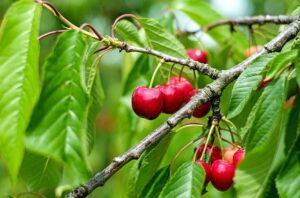The domestic cherries are ripening. The popular fruit will soon be available in larger quantities on the markets
The domestic cherry season started earlier than usual, the picking of the early varieties started already in mid-May, but a larger quantity of the popular fruit will be on the market at the beginning of June. According to the market map of the National Chamber of Agriculture and the Hungarian Fruit and Vegetable Association (FruitVeB), a better-than-average harvest is expected this year, but the weather, especially the rainfall during the ripening period, can significantly affect the actual yield.
By harvesting the early varieties, about two weeks earlier than usual, May 15-20. this year’s cherry season began between. Depending on the variety and region, the cherry harvest shows an extremely diverse picture nationally, which can be explained on the one hand by the locally occurring frost damage in April, the weather conditions experienced during the flowering period of the given variety and the region. In general, it can be said that after the mild winter, it was also warmer than usual during the flowering period. However, during the breeding season, cooler weather followed in some regions, which hindered the bees’ activity, thus resulting in incomplete breeding in some places.
National spring frost damage did not affect the plantations, despite this there were districts where the frost caused serious damage, for example in Zala and Szabolcs

(Photo: Pixabay)
According to the forecast of the National Chamber of Agricultural Economy (NAK) and the Hungarian Fruit and Vegetable Association (FruitVeB), we can expect a slightly higher than average harvest this year. In Hungary, in good years, around 10,000 to 15,000 tons of cherries are harvested. Although it is still very difficult to predict at such an early stage of the season (especially with regard to the current rainy season), compared to the previous two or three years, the crop loss so far is much smaller. Based on this, it is likely that farmers will be able to harvest 12,000 tons of cherries in 2024, or slightly more. Currently, the early ripening cherries are still being harvested: Bigarreau Burlat, Valery Chskalov are already arriving on the markets, and the Nimba harvest has also begun. Vera and Carmen are now being taken in southern Hungary. Although Hungarian cherries have been available on the markets for a week or two, larger quantities are expected to appear on the markets from the beginning of June. The late-ripening varieties will be available until the end of June as the ripening period advances.
In addition to the better-than-average quantity, the smaller fruit size can cause (mainly sales) problems
The biggest stumbling block of our cherry cultivation is the rainfall during the ripening period, which causes the cherry to crack. Thus, it becomes unfit for any further use. After the cherry has split open, fungal diseases transmitted through the wound destroy the fruit. Therefore, we can only hope for a secure commodity base from plantations covered with rain protection film above the trees. The largest production area is located in the county of Pest, where about 25 percent of domestic cherry production is concentrated, in addition, the counties of Bács-Kiskun, Jász-Nagykun-Szolnok, Fejér and Zala on Dunántúl, Borsod-Abaúj-Zemplén in the north, and Heves county in the east are also dominant.
Cherries are our very favorite early fruit, which is among the first fruits to ripen
Buyers typically look for large, shiny and dark red fruit. Such e.g. the Hungarian-bred Carmen, and Kordia and Regina are common among producers, but there are many Hungarian-bred varieties.
As in previous years, cherry exports are expected to be around a thousand tons per year on average, and are primarily directed to neighboring countries and the Baltics
Our cherry imports, on the other hand, reach 2-3 thousand tons per year, most of which come from Turkey, typically during the domestic season. The amount of Turkish imports also clearly shows that there is room for the development of domestic cherry cultivation. Breed innovation is continuous, we have internationally recognized, domestically bred varieties, and our cultivation technology and cultivation system are also world-class, all that is needed is capital and a sufficient number of well-trained production managers in order for the existing knowledge to be put to practical use.
NAK
Related news
AM: Government helps farmers with a loan moratorium
🎧 Hallgasd a cikket: Lejátszás Szünet Folytatás Leállítás Nyelv: Auto…
Read more >More than 100 Hungarian farmers also demonstrated in Brussels
🎧 Hallgasd a cikket: Lejátszás Szünet Folytatás Leállítás Nyelv: Auto…
Read more >Hungarian champagne crowns the end-of-year holidays!
🎧 Hallgasd a cikket: Lejátszás Szünet Folytatás Leállítás Nyelv: Auto…
Read more >Related news
Christmas shock in commerce: for the first time, we can pay with bank cards in fewer places
🎧 Hallgasd a cikket: Lejátszás Szünet Folytatás Leállítás Nyelv: Auto…
Read more >Hungarian Confectionery Manufacturers Association: trends in 2025 and prospects for 2026
🎧 Hallgasd a cikket: Lejátszás Szünet Folytatás Leállítás Nyelv: Auto…
Read more >Most grocery chains will be open until noon on December 24th
🎧 Hallgasd a cikket: Lejátszás Szünet Folytatás Leállítás Nyelv: Auto…
Read more >






